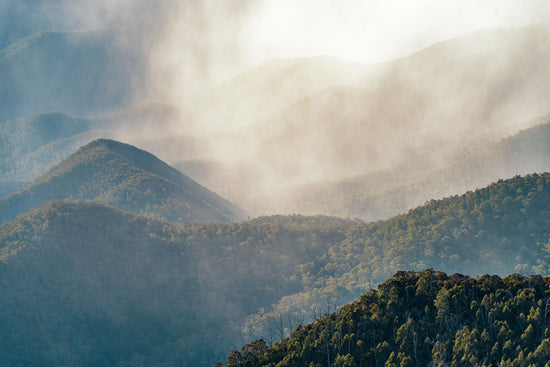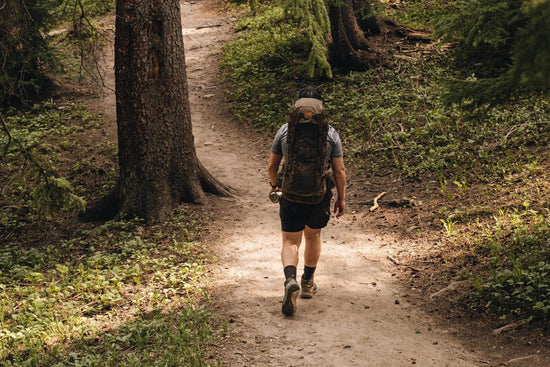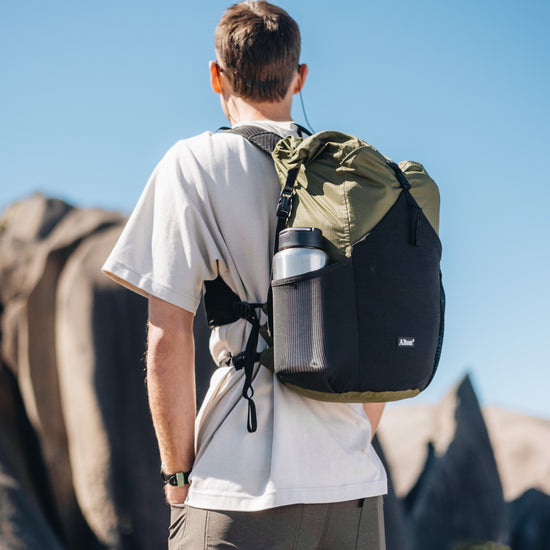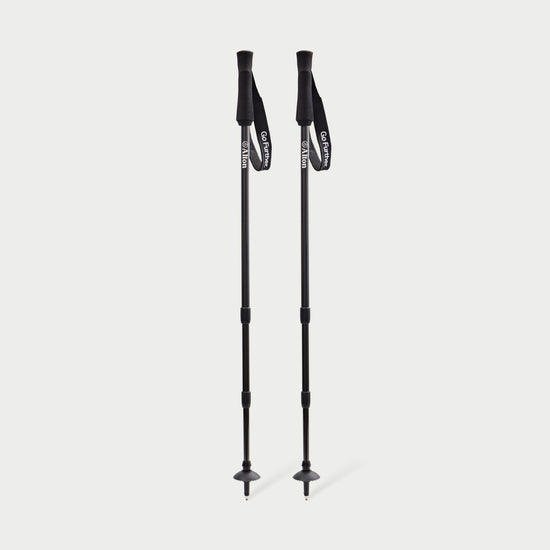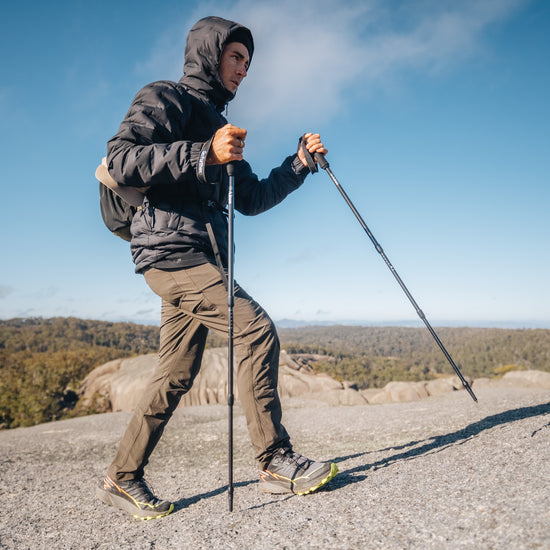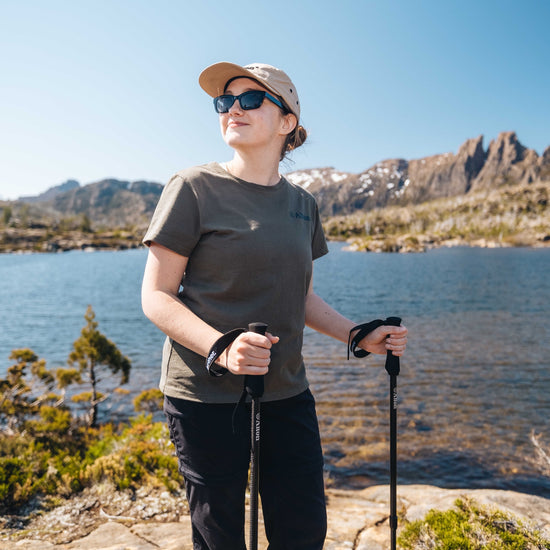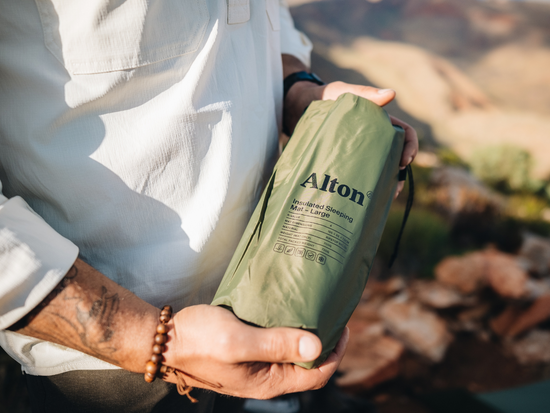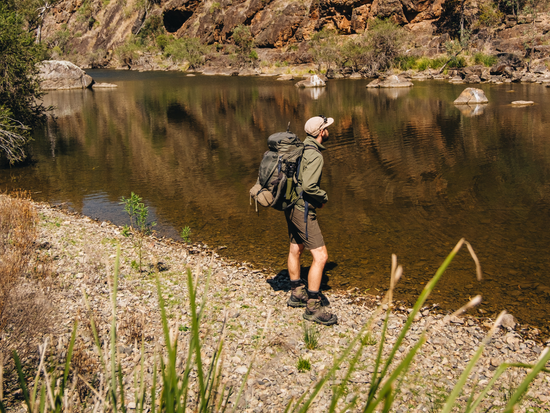Australia is spoiled when it comes to national parks. From tropical rainforests and rugged mountains to red deserts and wild coastlines, we’ve got a nature fix for every kind of adventurer.
And with well over 600 national parks across the country, you could spend a lifetime exploring all of them.
But with so many incredible parks to choose from, we had to ask the big question: what are the BEST national parks in Australia?
To find the answers, we turned to the real experts – you!
Over 2,700 Aussie campers, hikers, and nature lovers voted for their favourite national parks across the country in our most recent 2025 Outdoor Participation Survey.
The result?
A top 10 list packed with the very best of Australia’s national parks. These are your go-to local parks that every adventure-lover should visit at least once in their lifetime.
Get ready for jaw-dropping views, epic trails, endangered wildlife, and unforgettable adventures that you’ll be talking about for the rest of your life.
Ready to see which parks made the cut? Let’s dive in.

10. Great Sandy National Park (QLD)
Great Sandy National Park is a huge coastal park in Queensland with over 2,000km² of stunning beaches, dunes, mangroves, freshwater lakes, heathlands, and rainforests to explore.
Recognised as one of the most culturally and environmentally significant parks in all of Australia, Great Sandy National Park is a UNESCO World Heritage Site (K’gari), UNESCO Biosphere Reserve.
Nature & Landscape
The park has two sections, Cooloola Recreation Area and K'gari (previously Fraser Island), that both contain stunning and geologically unique landscapes and marine environments.
Spanning the coastline between Noosa Heads and Rainbow Beach, Cooloola Recreation Area is home to a vast array of habitats and microclimates, from towering sand dunes and coastal heathlands to lush rainforests and everglades.
Just off the coast, you’ll find K'gari, the world’s largest sand island. Stretching over 120 kms, K’gari is one of the most unique environments on earth. Shaped by the sand, wind and sea over hundreds of thousands of years, the island’s complex dune systems support dense forests, swamps, and freshwater lakes.
Great Sandy National Park is an internationally recognised biodiversity hotspot, with habitats ranging from wetlands and woodlands to beaches and marine environments.
The park is famous for its dingoes, but is also home to wallabies, sugar gliders, lace monitors, and more than 350 bird species including emus, honeyeaters, and the endangered eastern ground parrots. Marine life includes dolphins, dugongs, turtles, and migrating humpback whales.
Top Activities
From hiking, bird-watching, kayaking, fishing and 4WDing, Great Sandy National Park has something for everyone. Highlights include the Cooloola Great Walk, the Cooloola Way 4WD track, and exploring the Upper Noosa River waterway by kayak, canoe or packraft. And that’s just scratching the surface of what’s on offer!

9. Warrumbungle National Park (NSW)
Up next in 9th position overall is Warrumbungle National Park. Located in central New South Wales, this park is known for its dramatic volcanic landscape, rich biodiversity, and starry skies.
Nature & Landscape
The Warrumbungle Ranges are actually the remnants of a massive volcano that was active some 13-17 million years ago. The surreal spires, domes and peaks that the national park is famous for today were once the inner ‘plumbing’ of the volcano, now exposed after millions of years of erosion.
This park is also home to hundreds of different species of birds and animals, including wedge-tailed eagles, fairy-wrens, black cockatoos, eastern grey kangaroos, swamp wallabies, echidnas, and more. In spring and early summer you’ll see beautiful wildflowers, including the endemic Warrumbungle Star Flower, and native orchids, along with colourful grevilleas, wattles, and eucalyptus trees.
By night, Warrumbungle National Park is also famous for incredible stargazing, astronomy, and astrophotography opportunities.
In 2016, it was declared Australia’s first Dark Sky Park, and in 2018 the park was expanded to include the neighbouring Siding Spring Observatory. This observatory offers an uninterrupted view of the sky over the entire southern-hemisphere, making it one of the most important astronomy sites in the world.
Top Activities
With such beautiful scenery to explore, it’s not surprising that hiking and camping are some of the top activities on offer at Warrumbungle National Park. Other activities include cycling, cultural tours, and rock climbing.
The hiking trails in the park range from relaxed 15-20-minute nature walks to challenging full-day hikes, some of which can be done as overnighters. If you’re up for a longer hike, the Breadknife and Grand High Tops Walk and Mount Exmouth Walking Track are standouts.

8. Southwest National Park (TAS)
We were thrilled to see Tasmania’s Southwest National Park made it onto your list of the top 10 best national parks in Australia. It’s one of our personal faves here at Alton.
As one of the most pristine and remote national parks on earth, Southwest National Park is one of those places you can visit over and over again, and still feel like there’s so much more to discover.
This park’s unique combination of harsh, unpredictable weather conditions, low human presence, and difficult terrain makes it one of the most challenging – and rewarding – in all of Australia.
Nature & Landscape
Southwest National Park is a vast expanse of wilderness that forms part of the larger Tasmanian Wilderness World Heritage Area. Covering over 6,000 km2, it’s the largest national park in Tassie and is often referred to as one of the last pockets of ‘true wilderness’ left in the Southern Hemisphere, if not the world.
Southwest National Park feels like a world apart, with rugged mountain ranges, pristine rivers, buttongrass moorlands, ancient temperate rainforests, and windswept coastlines.
Most of Southwest National Park is inaccessible by road, with hundreds of kilometers of uninterrupted wilderness in every direction. In fact, the vast majority of the park is trackless and untouched, with vast areas where no human infrastructure exists at all.
The conditions in Southwest National Park can be punishing, with extreme, unpredictable weather year around. This, along with its extreme isolation and lack of human infrastructure, contributes to the park's impressive level of ecological integrity. It’s a sanctuary for many rare and endangered species, including the orange-bellied parrot, one of the world’s rarest birds, which only breeds in this region. This is also why the park is thought to have been the final stronghold for the now-extinct Tasmanian Tiger, or thylacine.
Top Activities
Southwest National Park is a magnet for serious adventurers seeking solitude and raw natural beauty, with some of the best (and hardest) hiking and wilderness experiences in the country.
The best day hikes include Duckhole Lake and Eliza Plateau, but there are also several gruelling multi-day hikes, including the South Coast Track and the Western Arthur Traverse.
Visitors to this park need to be prepared for extreme weather at any time of year. Conditions can change quickly and without warning, so even short day hikes require careful planning, proper clothing, footwear, food and equipment.
7. Mount Barney National Park (QLD)
Another one of our personal favourites, Mount Barney National Park, made it onto your top 10 best National Parks list.
Located in the Scenic Rim, Mount Barney National Park is only about 90 kms south of Brisbane, but it’s a must-visit for experienced hikers who are keen to push their limits (and aren’t afraid of heights).
Nature & Landscape
Mount Barney forms part of the Gondwana Rainforests of Australia World Heritage Area, a designated UNESCO-listed site. The rainforests found there are direct descendants of the forests that once covered the Gondwana supercontinent, making this area one of the oldest continuous ecosystems in the world.
At the heart of the park is Mount Barney, one of Queensland’s most impressive mountains, rising to 1,359 metres above sea-level. The surrounding landscape includes a network of other volcanic peaks, along with steep ridges, deep valleys, and crystal-clear creeks.
If you’re lucky, you might catch a glimpse of a rare brush-tailed rock-wallaby, or spot a lyrebird slinking through the undergrowth. These species and others like them thrive in this park’s remote and relatively undisturbed habitats.
Top Activities
Hiking, scrambling and rock climbing are Mount Barney National Park’s most popular activities. While being fairly close to Brisbane, this park is known for its difficult hikes. In fact, all the tracks there are rated Grade 4 or higher, meaning that walkers need prior bushwalking experience, some navigation skills, and a high level of fitness.
If you’re up for the challenge, then there are some rewarding day hikes here, including the Lower Portals track which leads to a deep freshwater pool at the base of a steep, rocky gorge.
There are several routes up to the summit of Mount Barney, but attempting any of these tracks is a serious undertaking that requires a high level of bushwalking experience, including navigation skills, climbing/scrambling, and emergency first-aid. Summiting should only be attempted in good weather conditions, as the rocks become very slippery when wet.

6. D'Aguilar National Park (QLD)
Just outside of Brisbane, D’Aguilar National Park can provide a much-needed escape from the city, with rainforests, secluded waterfalls, and a huge selection of multi-use tracks for hiking, biking, horse-riding and more.
Nature & Landscape
Covering around 400km2 of bushland, D'Aguilar is divided into two main sections: South D’Aguilar (previously Brisbane Forest Park) and Mount Mee. Together, these two areas form a part of the D'Aguilar Range, which rises from the surrounding lowlands to create a cool, forested retreat close to the city.
Boasting over 100 km of walking trails, visitors to D’Aguilar can explore a wide variety of landscapes, including eucalypt forests, subtropical rainforest, hoop pine plantations, rocky outcrops, and seasonal creeks.
D'Aguilar National Park’s rainforest gullies and high ridges also provide an important refuge for threatened species and are part of a broader conservation corridor linking this area to the Moreton Bay region. As a result, this area is an important habitat for rare marsupials, birds, reptiles, and insects.
Top Activities
D’Aguilar is one of the most accessible national parks on our list today, with walking tracks and activities suitable for all fitness and experience levels. This makes it a favourite destination for families, day-trippers, and campers who are eager for a relaxing weekend escape.
That said, there is no shortage of tracks or activities for those craving a challenge. Because there are so many trails and bush campsites throughout the park, you can easily create your own multi-day circuits, which can be completed on foot, bicycle, or even on horseback in some areas.

5. Tasman National Park (TAS)
In fifth place in your top 10 best Australian national parks is another gem from Tasmania: Tasman National Park.
Only a short 1.5hr drive from Hobart in southeast Tasmania, Tasman National Park is a spectacular coastal area famous for its towering sea cliffs, dramatic rock formations, and thriving marine life.
Nature & Landscape
Located on the windswept Tasman Peninsula, the landscape in and around Tasman National Park is pretty special.
Covering a little over 100km2 of land and marine environments, this park features towering dolerite cliffs, some of the highest in the Southern Hemisphere, rising up to 300 metres straight out of the sea.
For geology-buffs and ocean-lovers, this park is hard to beat. There are unique rock formations all along the coast, and just offshore you’ll find dense kelp forests and precious marine ecosystems. Inland, the park features heathlands, dry sclerophyll forests, and patches of coastal rainforest that support many rare endemic plants and animals.
The waters off the coast of the park, particularly around Fortescue Bay and the Three Capes, are part of a protected marine ecosystem that is teeming with life. Visitors often see seals, dolphins, and whales during their migration, as well as seabirds such as sea-eagles, albatrosses, and penguins.
Top Activities
Tasman National Park’s top activities include hiking, photography, diving, snorkelling, birdwatching, sailing/boating, and fishing.
Most of the hiking tracks are well-maintained and easily accessible, although there are some longer options available, including the Tasman Coastal Trail which can be combined with the Tasman Cape Pillar track into a 4-5 night hike.

4. Wilsons Promontory National Park (VIC)
In fourth place we have Wilsons Promontory, a.k.a ‘The Prom’ - yet another coastal national park!
With its beautiful scenery, huge variety of activities to enjoy, and close proximity to Melbourne, it’s pretty easy to see why this park made it into your top 10 best Australian national parks.
Nature & Landscapes
Located along the southernmost coast of mainland Australia, about 3 hours’ drive from Melbourne, Wilsons Promontory National Park is celebrated for its spectacular coastal landscape, granite mountains, pristine beaches, and abundant wildlife.
Covering about 500km2, this park is incredibly diverse. Towering granite peaks, such as Mount Oberon and Mount Bishop, rise above dense eucalypt forests, fern-filled gullies, and sweeping coastal heathlands.
As you reach the coastline, you’ll find white sandy beaches, turquoise waters, rocky headlands, and sheltered coves. The wetlands and river systems along the coast also contribute to the park's rich habitats and ecosystems, both on- and off-shore.
Back on land, the park is home to lots of native wildlife, including kangaroos, wombats, emus, echidnas, and wallabies, many of which are often seen around campgrounds and walking tracks.
Top Activities
If you enjoy sweeping views, secluded beaches, and lush rainforests, then Wilsons Promontory National Park won’t disappoint.
The park has over 80 km of walking tracks, with trails ranging from short strolls like Loo-Errn Boardwalk to the challenging multi-day Southern Circuit hike to South Point, the southernmost tip of mainland Australia.
Visitors can also enjoy swimming, surfing, bird watching, kayaking, and guided tours and activities, so there is no shortage of things to do in this iconic Australian park.
3. Grampians National Park (VIC)
In third place, we have Grampians (Gariwerd) National Park! Tucked away in the hills of southwest Victoria not far from the border with South Australia, this beloved park has so much going for it – incredible hiking, stunning scenery, and ancient cultural history.
Nature & Landscape
Covering over 1,600km2, Grampians National Park is known for its rugged mountain ranges, deep gorges and gullies, waterfalls, and thousands of hectares of forest.
This park contains over 1,000 native plant species (more than a third of Victoria’s total), including beautiful endemic wildflowers that bloom every spring. Wildlife is abundant, with emus, echidnas, koalas, kangaroos, and many other, more elusive marsupials, birds, and reptiles.
The Grampians, known as Gariwerd by the Traditional Owners of the land, are also one of the richest areas for Aboriginal cultural heritage in southeastern Australia, containing over 80% of Victoria’s known rock art sites. These ancient sites and shelters, created by the Jardwadjali and Djab Wurrung peoples, offer deep insight into the spiritual and cultural connection to Country.
Top Activities
Top activities in Grampians National Park include hiking, with popular walks to The Pinnacle and MacKenzie Falls, as well as rock climbing, plant identification, bird watching, and cultural tours.
You don’t have to go far to find panoramic views over forests, valleys, and surrounding plains, as there are plenty of lookout points along the road. But, for those willing to go a bit further afield, there are numerous multi-day hikes in the park, including the world-class Grampians Peaks Trail, a 13-day walk that traverses the entire park from north to south.
Unfortunately, Grampians National Park was badly affected by bushfires in 2024/25. There are large-scale recovery works in progress, but some areas remain closed to the public. Visitors should check for the latest updates on track closures and other important information before making plans.
2. Kosciuszko National Park (NSW)
Home to Australia’s highest peak, Kosciuszko National Park is one of the best locations in the country for winter sports, as well as alpine hiking, mountain biking and more. As an all-year-round destination for nature lovers, we can totally understand why it ranked so highly in your top 10 best Australian national parks list.
Nature & Landscape
Located in southern New South Wales, Kosciuszko National Park is the largest national park in the state. It’s also where you’ll find Australia’s highest peak, Mount Kosciuszko, at 2,228 metres high.
This park makes up a part of the Australian Alps, a massive mountain range that spreads across the borders of New South Wales, Victoria and the Australian Capital Territory and makes up the Australian Alps National Parks and Reserves, a UNESCO-recognised biosphere.
Famous for its alpine scenery, unique ecosystems, snow sports, and cultural heritage, Kosciuszko National Park is incredibly diverse, ranging from rocky peaks and alpine meadows to secluded valleys, forests, and caves.
In winter, the park transforms into a snow-covered playground with popular ski resorts drawing thousands of visitors each year. In warmer months, snow melts to reveal flower-filled alpine plains, with dozens of hiking and bike trails that lead you through the high country wilderness areas.
As one of the only places in Australia where true alpine and subalpine environments exist, this park protects many rare and endemic species, including the mountain pygmy-possum, corroboree frog, and alpine she-oak skink.
Top Activities
Top activities in Kosciuszko National Park include hiking, mountain biking, camping, skiing and snowboarding, fishing, wildlife watching, caving, and more. And with seven unique areas and about 6,900km2 to explore, you’ll never run out of things to see and do.
Some of the most rewarding experiences on offer in the park include hiking or riding to the summit of Mount Kosciuszko, skiing or snowboarding at Thredbo, road tripping along the Alpine Way drive, and doing an overnight or multi-day hike, such as the Main Range walking track.
1. Blue Mountains National Park (NSW)
In first place as the BEST national park in Australia (as voted by over 2,700 experienced outdoor enthusiasts) is the Blue Mountains National Park.
Located just west of Sydney in New South Wales, this iconic park is famous world-wide and hosts around 4 million visitors every year. As many of them would tell you, the Blue Mountains are special – and a must-visit for everyone who loves the outdoors.
Nature & Landscape
Spreading over 2,600km2, the Blue Mountains National Park forms a part of the Greater Blue Mountains World Heritage Area, a UNESCO-listed site that’s recognised for its biodiversity and cultural heritage.
The park gets its name from the blue haze that rises from the vast eucalyptus forests, caused by oils released from the leaves. The landscape is varied, ranging from towering cliffs and deep valleys, to cascading waterfalls and ancient forests.
Blue Mountains National Park is a haven for native flora and fauna. It supports rare and threatened species like the spotted-tailed quoll, greater glider, and Blue Mountains water skink, as well as rare plants including the Wollemi pine.
The area holds deep spiritual and cultural significance for the Gundungurra and Darug peoples, with ancient rock art, sacred sites, and many Dreaming stories connected to the landscape. Today, the Traditional Owners continue to play an important role in the management, protection, and cultural interpretation of Blue Mountains National Park.
Top Activities
Top activities in Blue Mountains National Park include bushwalking, rock climbing, canyoning, bike riding, wildlife and bird watching, and visiting scenic lookouts such as Echo Point and Govetts Leap.
There are over 140 kms of walking trails that range from short strolls to challenging multi-day hikes like the Mount Solitary Walking Track, so there is something for everyone.
Due to the park’s popularity, there are also lots of guided tours and activities on offer, ranging from photography workshops, kid-friendly activities, 4WD trips, cycling trips, guided hikes, ranger-led discovery tours and so much more.
So, which Australian national park is your favourite?
So there you have it: Australia’s top 10 best national parks, as voted by 2,700+ experienced Aussie outdoor enthusiasts.
What did you think? Did your top park make the list? If you think there is a park out there that deserves a special shout out, head over to this post on our Instagram and let us know why it deserves some more attention.
Whichever park is your personal favourite, we think that we can all agree that we have some amazing places right here in our backyard. As an outdoor brand (and outdoor-lovers), we are grateful to be able to visit these epic natural places. Whether it’s a quick day hike or a week-long trek into the wilderness, these parks give us so much.
That’s why it’s on all of us to do our bit to protect them. Whenever you’re out in nature, remember to leave no trace, respect wildlife, and tread lightly, so that people can continue to enjoy these wild places for generations to come.

